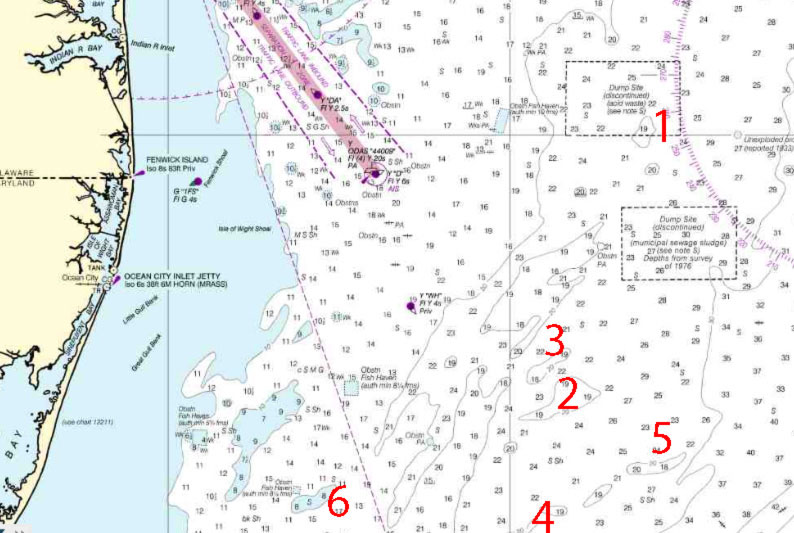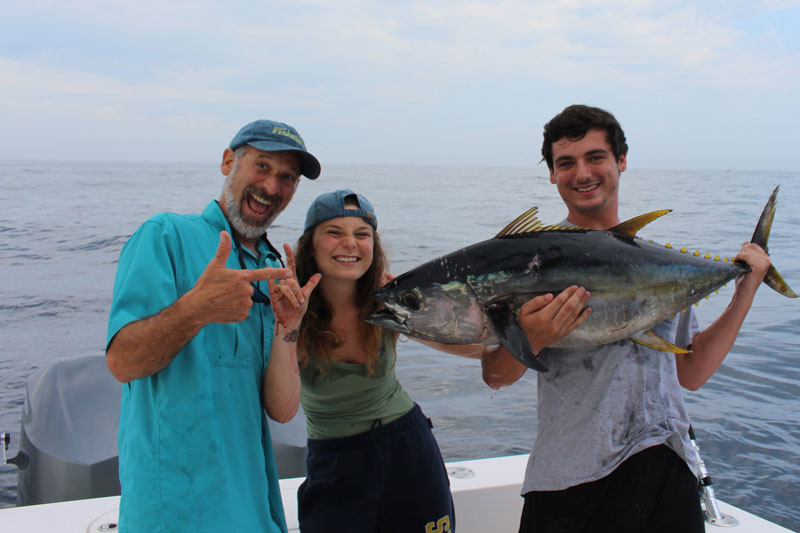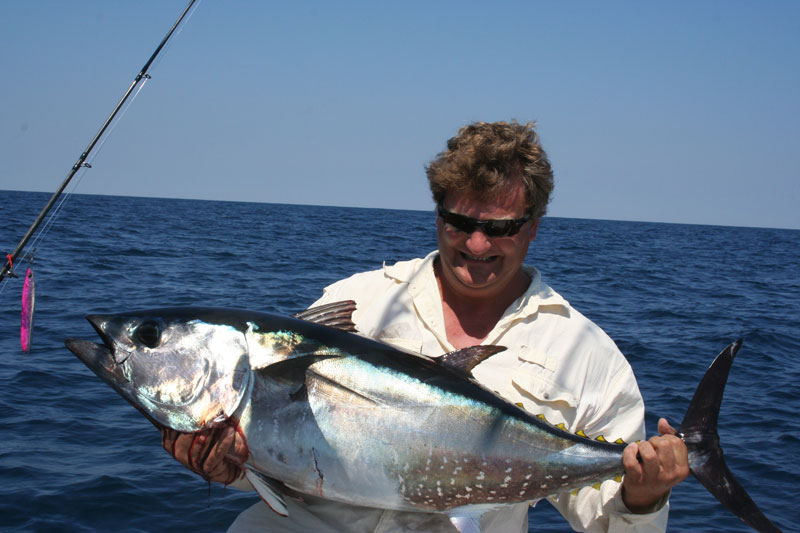When tuna move up the coast, anglers from Wachapreague to Indian River hope and pray that they decide to set up shop at the inshore lumps and hotspots like the Inshore Deli. With the fish feeding just 20 to 40 miles from the inlets, usually in water as shallow as 140 or fewer feet, fishing for big game becomes a whole lot easier. Half the running time and half the fuel costs associated with cruising to the canyons is quite enticing. Added bonus: the fish can only dive so far, and using lighter than normal tackle becomes possible. When it happens, these tactics will put them into the box.

Tuna Chunking
Chunking for yellowfin is a favored method for pounding on tuna at inshore lumps for several reasons: it’s highly effective, it allows you to fish much deeper baits than you can when trolling, and it’s a relatively easy tactic to master. That said, there are a few chunker’s tricks that separate the sharpies from the wannabes.
The basic concept is easy as pie. Toss handfuls of cut fish or squid (butterfish is most common) over the side of the boat to attract hungry fish, while also tossing out hooks baited with the same chunks. It’s important, however, to make sure that your offerings cover the water column — yet at the same time are positioned amongst the falling chunks. This is easier said than done, since you’ll have to let different length lines out to different distances. A bait set under a float at 15 feet, for example, will be dangling near your chunks just 20 or 30 yards behind the boat. But a bait set at 50 feet will need to be significantly farther back to be in the chunk flow. And just how far that is will vary depending on factors like current and wind.
Along with baits set at specific depths, anglers need to be stripping back lines. Not should be – need to be. While any particular line can be hot any particular day, over the long haul these “feeder” lines, as they’re often called, catch twice as many tuna as any other. The rigs consist of a straight line-leader-baited hook, with no additional weight or tackle except possibly a swivel. Most anglers will use 50- to 80-pound fluorocarbon leaders tied off with 8/0 to 10/0 circle hooks, though the tuna do commonly get line-shy mid-season and leader size may need to be dropped all the way back to 30-pound test in order to get a bite. The bait should be dropped next to the boat as a handful of chunks go over the side, with the rod in a holder and the reel in freespool with the clicker on. As the bait sinks naturally with the chunks, the angler grabs the line above the rod’s tip and consistently strips it out, so there’s never any tension on it. This allows the bait to sink as naturally as possible, right amongst all those chunks. If it doesn’t get hit in five or 10 minutes, crank it back and start over again.

Finally, unless you’re getting mauled the moment your feeder lines pass from sight you should set a bait on bottom. While it occasionally accounts for a yellowfin, more commonly, this is the line that gets attacked by any larger bluefin that may be in the area. Standard operating procedure is to weight this line with 10 to 16 ounces of lead attached via a rubber band so it breaks away on the strike. Set it 10 or 12 feet off bottom, and allow it to rock with the motion of the boat.
One big question you’ll commonly hear when discussing chunking on the inshore lumps: how do you know whether to anchor or drift? This is dictated by the combination of wind and tide. If the boat sits at anchor in such a way that the lines trail behind it, great. Anchoring will allow you to sit right over an edge or contour of the lump and pound on the fish. But if the wind and current conspire to draw your lines under the boat or into constant tangles, it’s best to try repeated drifts across the spot. Also note that if a fleet is drifting you’ll cause havoc by anchoring right in the middle of them. Conversely, when everyone’s riding at anchor drifting through can also make for problems.
Trolling for Tuna
Trolling at the inshore lumps is usually best early in the season, before large numbers of boats set up shop chunking. Once a fleet begins chunking, it can become extremely tough to distract the fish from the “free” food and try to get them to chase after your trolled baits.
Spreads for trolling inshore lumps are commonly 100-percent tuna-centric; while these fish most certainly will hit the dink ballyhoo commonly run for whites or the horse you tow for larger fish, a mix of medium-sized offerings is the norm. Skirted medium ‘hoo, Green Machines run behind birds, spreader bars, and feathers or clones should all be on the list.
One important note: when bluefin are around in good numbers, a blue/white Ilander rigged with a ballyhoo is a must. This lure can be particularly effective when the bluefin are sighted on the meter but seem unwilling to come to the surface to bite, often due to an ocean overcrowded with boats. Run it in a way, way, way back position, as much as several hundred yards behind the boat, and when fish are spotted down deep some captains will even shift out of gear for a bit and allow the Ilander to sink.
Jigging for Tuna

The inshore lumps also present an awesome opportunity for anglers who want to hook tunas on jigs. There are two basic methods applied: the first is to jig while chunking, and the second is to scout for fish on the meter then drop jigs directly onto the fish’s heads.
Jigging in a chunk line is exactly what you’d expect: drop the lure down to the bottom while other anglers work the chunk rods, vertically jig it a time or three, then speed-jig it back to the boat. Five- to seven-inch jigs are usually best since they have enough weight to get down deep quickly but are still small enough for a decent-sized tuna fish to inhale. Larger jigs often take a lot of missed hits, and remember, the sand eels which regularly attract tunas to the lumps (and which those jigs certainly must look like as they flutter around) are usually small enough to fit in your hand.
When there are schools or pods of tuna shadowing schools of sand eels down close to the bottom, keeping on the move and scouting for the fish is much more effective than jigging in a chunk line. Motor around, looking for the clouds of light-colored marks on your meter that denote the schools of sand eels. Find these, and you know it’s time to work the area a little more thoroughly. If you start seeing big red arches hovering close by those lighter marks, shift into neutral and send the jigs down to the fish’s depth. Again, it’s usually best to stick with jigs small enough that the tuna can simply inhale them; pink, blue, and green metallic color patterns tend to be stand-out offerings.
Are those tunas set up along the inshore lumps right now? We can’t say as we go to print — check the fishing reports to get the current intel. But one thing is for sure: sooner or later those fish will stage on the underwater humps and bumps just 20 to 40 miles from the inlet. And when they do, anglers up and down the coast will be enticed beyond all ability to resist.
GPS Coordinates for Popular Inshore Lumps
Finding the inshore lumps isn’t difficult, as these spots have been well known since the days of LORAN and when the tuna are in town, commonly have dozens of boats in attendance. Here are some top starting points.
Off Delaware, the closest lump to hold tuna with any real frequency is the Dump Site Lump (1), about 44 miles out at 38’30.1 x 74’13.1. Running out from OC or Wachapreague the “Inshore Deli” is the place to be. It consists of the Ham Bone (2), 36 miles from the inlet at 38’11.9 x 74’24.5; the Chicken Bone (3), 32 miles at 38’14.0 x 74’26.7; the Sausages (4) at 38 miles off (to the middle lump) at 38’03.9 x 74’25.9; and the most famous of them all, the Hot Dog (5), 44 miles out at 38’06.9 x 74’17.2. Some years tuna will also come as close in as the Jack Spot (6), just 24 miles from the OC inlet, at 38’05.2 x 74’45.1.